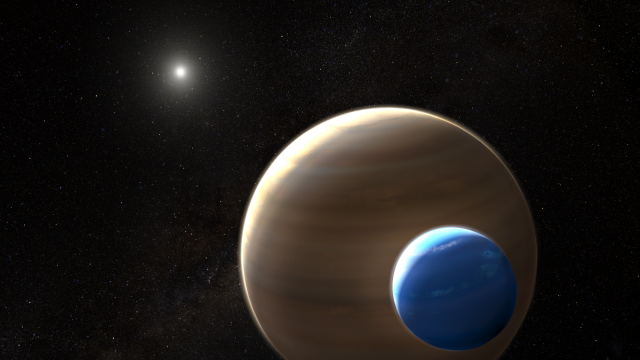By scouring archival data from the now-retired Kepler space telescope, astronomers have found a promising new exomoon candidate, in what is an exceptionally rare discovery.
To date, astronomers have confirmed the existence of 4,884 planets beyond our solar system, with another 8,414 waiting to be confirmed. Despite this, astronomers have yet to confirm the presence of an exomoon in orbit around any of these exoplanets. That’s surprising when you consider that our solar system alone hosts over 175 moons.
Yes, potential exomoons have been spotted over the years, including the very promising Kepler-1625 b-i candidate, which astronomers detected in 2018, along with a batch of supposed exomoons described in 2020 that independent analyses have subsequently ruled out (see here and here). But these sightings continue to be rare. Encouragingly, we can now add a new exomoon to this achingly small candidates list, as scientists announced today in a new Nature Astronomy paper.
Frustratingly, it’s yet another candidate exomoon “that will require follow-up” observations, as both the “nature and supporting evidence demand appropriate scepticism at this time,” the scientists write in their study. The paper estimates that there’s a 1% chance that the observed exomoon signal is a false positive, which, as far as scientists are concerned, is an intolerable amount of uncertainty.
I asked Columbia University’s David Kipping, the first author of the new study, why astronomers have struggled to confirm the presence of natural satellites around distant exoplanets. “Exomoons,” he replied in an email, “are generally expected to be small and have their signals mixed up with their larger planet host, making them challenging to disentangle.”
The transit method of detection, it’s fair to say, is partly responsible for this. Astronomers can spot exoplanets by measuring the periodic dimming of distant stars, a result of an object temporarily passing in front. Discerning a signal within this signal — especially for a tiny moon — is proving to be a challenge. At the same time, the transit method has led to a bias in which astronomers favour exoplanets with short orbital periods (these exoplanets pass in front of their host stars more frequently, allowing for repeated observations over short timescales). Trouble is, planets in close proximity to their host stars may not be the best candidates for hosting exomoons.
Our solar system is a prime example of this; the gas and ice giants Jupiter, Saturn, Uranus, and Neptune are located far from the Sun, but they’re surrounded by moons. With this in mind, Kipping and his colleagues decided to study cool exoplanets with long orbital periods in hopes of spotting exomoons.
To do so, they looked at data gathered by the late, great Kepler space telescope. A “small sample of long-period planetary candidates was discovered by Kepler — worlds with orbits greater than that of the Earth around the Sun,” the scientists write in their study. “The Jupiter-sized planets amongst these are of particular interest, as satellite formation is thought to be a natural outcome of how such planets form.”
The team honed in on 70 gas giant exoplanets, all of which feature orbital periods longer than one year. Of these, only one exhibited a signal consistent with an exomoon, but it was a signal nonetheless. The apparent exomoon “causes a transit just like the exoplanet does,” but “that second transit is much shallower and overlaps with the primary dip,” Kipping told Gizmodo.
The exomoon candidate was found with the Jupiter-sized gas giant Kepler-1708 b, which orbits a Sun-like star at a distance of 1.6 AU (in which 1 AU is the average distance from Earth to the Sun). The candidate has been designated Kepler-1708 b-i, in which the “i” represents the alleged exomoon.
Fascinatingly, at 2.6 times the size of Earth, this moon is rather large. We obviously don’t have anything quite like this in our solar system, the largest moon being Jupiter’s Ganymede, which is less than half the size of Earth. This observation is also interesting because Kepler-1625 b-i, the exomoon candidate spotted in 2018, is also very big. Thus, “Kepler-1708 b-i joins Kepler-1625 b-i as another example of an unexpectedly large exomoon candidate — echoing the surprise that hot-Jupiter discoveries elicited in the mid-1990s,” the scientists write.
The challenge now will be to figure out how these large moons formed and how they came to settle in orbits around long-period gas giants. Assuming, of course, these are actual exomoons and not a colossal wild-goose chase. Explanations posited in the new paper include planet-on-planet collisions, the formation of moons within gaseous circumplanetary disks, or direct gravitational capture.
The answer, regardless of what it is, will undoubtedly tell us something new about planetary systems and how they form. But first thing’s first: Astronomers still need to confirm these objects as being bona fide exomoons. Hopefully, future observations by the recently launched Webb telescope and other observatories will provide this much-needed answer.
